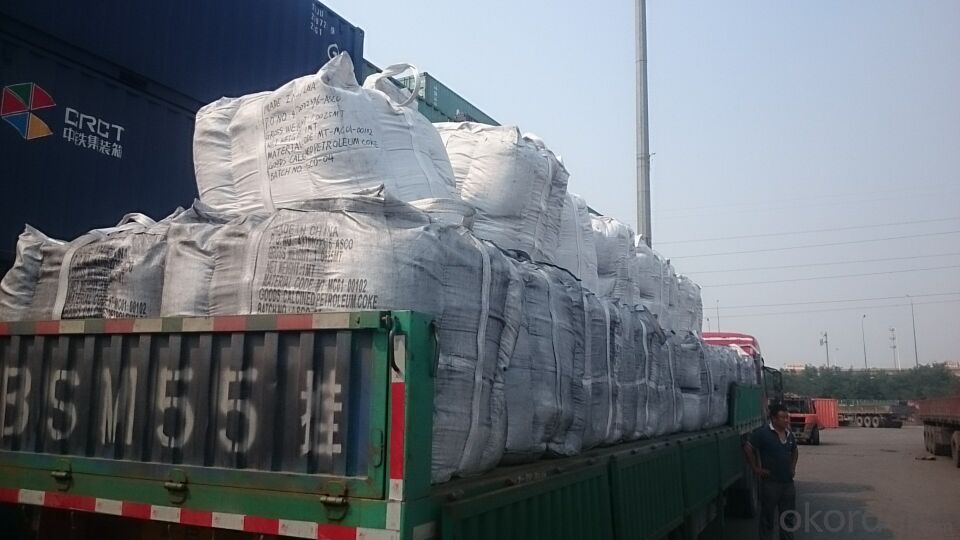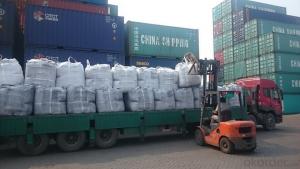GPC with lower N0.03% max in Low VM with smaller size
- Loading Port:
- Tianjin
- Payment Terms:
- TT OR LC
- Min Order Qty:
- 21 m.t.
- Supply Capability:
- 5000 m.t./month
OKorder Service Pledge
OKorder Financial Service
You Might Also Like
Introduction:
GPC has good characteristics with low ash, low resistivity, low sulphur, high carbon and high density. It is the best material for high quality carbon products. It is used as carbon additive in steel industry or fuel.
Features:
1.Our strong team provide you reliable service that make you feel purchasing is more easier
2. We ensure that we can supply capability with competitive price.
3. Work strictly to guarantee product quality,
4. Highest standard of integrity. Guarantee customer's benefit.
5. Supplying Pet Coke, Met coke, Foundry Coke, Carbon Raiser etc.
Specifications:
F.C.% | 95MIN | 94MIN | 93MIN | 92MIN | 90MIN | 85MIN | 84MIN |
ASH % | 4MAX | 5MAX | 6 MAX | 6.5MAX | 8.5MAX | 12MAX | 13MAX |
V.M.% | 1 MAX | 1MAX | 1.0MAX | 1.5MAX | 1.5MAX | 3 MAX | 3 MAX |
SULFUR % | 0.3MAX | 0.3MAX | 0.3MAX | 0.35MAX | 0.35MAX | 0.5MAX | 0.5MAX |
MOISTURE % | 0.5MAX | 0.5MAX | 0.5MAX | 0.5MAX | 0.5MAX | 1MAX | 1MAX |
Pictures



FAQ:
1. Your specification is not very suitable for us.
Please offer us specific indicators by TM or email. We will give you feedback as soon as possible.
2. When can I get the price?
We usually quote within 24 hours after getting your detailed requirements, like size, quantity etc. .
If it is an urgent order, you can call us directly.
3. Do you provide samples?
Yes, samples are available for you to check our quality.
Samples delivery time will be about 3-10 days.
4. What about the lead time for mass product?
The lead time is based on the quantity, about 7-15 days. For graphite product, apply Dual-use items license need about 15-20 working days.
5. What is your terms of delivery?
We accept FOB, CFR, CIF, EXW, etc. You can choose the most convenient way for you. Besides that,
we can also shipping by Air and Express.
6. Product packaging?
We are packed in bulk ship or in ton bag or placing in container or according to your requirements.
7. Notice
please note that the price on Alibaba is a rough price. The actual price will depends on raw materials, exchange rate wage and your order quantity .Hope to cooperation with you, thanks !
- Q:How does carbon affect the formation of ground-level ozone?
- Carbon does not directly affect the formation of ground-level ozone. Ground-level ozone is primarily formed through a complex chemical reaction involving oxides of nitrogen (NOx), volatile organic compounds (VOCs), sunlight, and heat. However, carbon-based compounds, such as hydrocarbons, can indirectly impact the formation of ground-level ozone. When carbon-based compounds, like hydrocarbons, are emitted into the atmosphere from sources such as vehicles, industrial processes, and fossil fuel combustion, they can react with nitrogen oxides in the presence of sunlight to form ozone. This reaction occurs in the presence of volatile organic compounds (VOCs) and nitrogen oxides (NOx), which are the primary precursors of ground-level ozone. Elevated levels of carbon-based compounds, particularly in the presence of NOx and sunlight, can enhance the formation of ground-level ozone. This is because the carbon-based compounds act as catalysts, accelerating the chemical reactions that lead to ozone formation. Additionally, the combustion of carbon-based fuels, such as gasoline and diesel, releases nitrogen oxides into the atmosphere, which can further contribute to the formation of ground-level ozone. It is important to note that carbon-based compounds alone do not directly cause ground-level ozone pollution. Rather, they contribute to the formation of ground-level ozone when combined with other pollutants, such as nitrogen oxides and sunlight. To mitigate the formation of ground-level ozone, it is necessary to reduce emissions of carbon-based compounds, as well as other ozone precursors like nitrogen oxides and volatile organic compounds.
- Q:Material characteristics of carbon fiber
- Carbon fiber is a kind of new material with excellent mechanical properties due to its two characteristics: carbon material, high tensile strength and soft fiber workability. The tensile strength of carbon fiber is about 2 to 7GPa, and the tensile modulus is about 200 to 700GPa. The density is about 1.5 to 2 grams per cubic centimeter, which is mainly determined by the temperature of the carbonization process except for the structure of the precursor. Generally treated by high temperature 3000 degrees graphitization, the density can reach 2 grams per cubic mile. Coupled with its weight is very light, it is lighter than aluminum, less than 1/4 of steel, than the strength of iron is 20 times. The coefficient of thermal expansion of carbon fiber is different from that of other fibers, and it has anisotropic characteristics. The specific heat capacity of carbon fiber is generally 7.12. The thermal conductivity decreases with increasing temperature and is negative (0.72 to 0.90) parallel to the fiber direction, while the direction perpendicular to the fiber is positive (32 to 22). The specific resistance of carbon fibers is related to the type of fiber. At 25 degrees centigrade, the high modulus is 775, and the high strength carbon fiber is 1500 per centimeter.
- Q:How does carbon occur in nature?
- Various forms of carbon occur naturally in nature and it is one of the most abundant elements on Earth. It can be found in the atmosphere, the Earth's crust, and living organisms. In the atmosphere, carbon primarily exists as carbon dioxide (CO2), which is produced through natural processes like respiration, volcanic activity, and the decay of organic matter. Plants absorb this CO2 during photosynthesis to generate energy and release oxygen. Carbon is also present in other greenhouse gases like methane (CH4), which is produced by natural processes such as the decomposition of organic matter in wetlands and the digestive processes of certain animals. In the Earth's crust, carbon is present in various minerals like limestone, dolomite, and graphite. These minerals form over millions of years through the accumulation of marine organisms, such as shells and skeletons. Carbon is also a vital component of fossil fuels like coal, oil, and natural gas, which are formed from the remains of ancient plants and animals subjected to high pressure and temperature over time. Additionally, carbon is an essential element for all living organisms and serves as the foundation of organic chemistry. It is the primary component of organic matter, including carbohydrates, proteins, lipids, and nucleic acids, which are the building blocks of life. Through processes like photosynthesis, respiration, and decomposition, carbon cycles continuously within ecosystems. In conclusion, carbon occurs naturally in different forms in the environment and plays a critical role in the Earth's climate system, geological processes, and the sustenance of life.
- Q:How does carbon dioxide affect the acidity of rainwater?
- Carbon dioxide (CO2) dissolves in rainwater to form carbonic acid (H2CO3), which increases the acidity of the rainwater.
- Q:How do you stick carbon fabric?
- 3. Apply the base resin(1) the main agent and curing agent base resin according to the provisions of the proportion accurate weighing were put into the container, use a blender to mix uniformly. A harmonic volume should be in use within the time spent more than can be used as the standard, time cannot be used.(2) apply the base coat evenly with a roller brush(3) refers to the drying time, due to different temperatures, generally between 3H to 1D changes(4) after the curing of the base coat, when the surface of the component has a condensation bulge, it should be polished with sandpaper. If the surface of the concrete is exposed after polishing, the bottom coating shall be applied again4, the incomplete repair of the surface of the componentThe surface depressions (honeycomb pits, holes, etc.) using epoxy putty to fill, to repair the surface. (the poor, camber angle etc.) to be filled with epoxy putty, so smooth.
- Q:What are the potential uses of carbon nanomaterials in medicine?
- Carbon nanomaterials have shown great promise in the field of medicine due to their unique properties. One potential use of carbon nanomaterials is in drug delivery systems. Their high surface area-to-volume ratio allows for efficient loading and release of therapeutic agents, enabling targeted and controlled drug delivery. This could lead to more effective treatments with reduced side effects. Another potential use is in medical imaging. Carbon nanomaterials, such as carbon nanotubes and graphene, have excellent optical and electrical properties that can enhance imaging techniques like MRI and CT scans. This could improve the accuracy and resolution of medical imaging, enabling better diagnosis and monitoring of diseases. Carbon nanomaterials also have antibacterial properties which can be utilized in wound healing and infection control. Nanostructured carbon materials can effectively kill bacteria and prevent the formation of biofilms, which are often resistant to conventional antibiotics. This could potentially revolutionize the treatment of infections, especially those caused by antibiotic-resistant bacteria. Furthermore, carbon nanomaterials have the potential to be used in tissue engineering and regenerative medicine. Their biocompatibility, mechanical strength, and electrical conductivity make them suitable for creating scaffolds to support tissue growth and promote regeneration. Carbon nanomaterials could also be used to enhance the electrical stimulation of tissues, aiding in nerve regeneration and improving the functionality of artificial organs. In addition to these applications, carbon nanomaterials have been explored for their ability to detect and monitor diseases at an early stage. Their unique electronic and optical properties can be utilized in biosensors and diagnostic devices, allowing for sensitive and specific detection of biomarkers associated with various diseases. While the potential uses of carbon nanomaterials in medicine are vast, it is important to note that further research and development are required to ensure their safety, efficacy, and long-term effects. Regulatory considerations and ethical concerns surrounding the use of nanomaterials in medicine also need to be addressed. Nonetheless, the promising capabilities of carbon nanomaterials offer hope for more advanced and personalized medical treatments in the future.
- Q:How does carbon affect the formation of tornadoes?
- Carbon does not directly affect the formation of tornadoes. Tornadoes are primarily formed due to the interaction of warm, moist air with strong wind shear. However, carbon emissions and climate change can contribute to the overall increase in severe weather events, including tornadoes, by altering atmospheric conditions and increasing the energy available for storm development.
- Q:What are the properties of carbon-based rubber?
- Carbon-based rubber, known also as carbon black-filled rubber, possesses a range of important properties that make it highly desirable for a variety of applications. To begin with, carbon-based rubber demonstrates excellent elasticity and flexibility, enabling it to endure repeated stretching and compression without permanent deformation. This particular quality renders it ideal for the manufacturing of products like tires, gaskets, and seals. Moreover, carbon-based rubber exhibits exceptional resistance to abrasion and wear, ensuring its longevity even in harsh conditions and with prolonged use. This attribute proves particularly advantageous in applications where the rubber material experiences friction or constant contact with rough surfaces. Additionally, carbon-based rubber showcases remarkable resistance to various environmental factors. It boasts excellent resistance to ozone, sunlight, and weathering, making it suitable for outdoor applications where exposure to UV radiation and extreme temperatures is expected. Its resistance to chemicals and oils further enhances its versatility, enabling its use in industries such as automotive, aerospace, and manufacturing. Another notable property of carbon-based rubber is its electrical conductivity. This characteristic renders it an ideal material for applications that necessitate static dissipation or protection against electrostatic discharge, such as in electronic devices, conveyor belts, and industrial flooring. Furthermore, carbon-based rubber displays good adhesion to various substrates, allowing it to form strong bonds when employed in adhesive applications or as a lining material. Overall, the exceptional elasticity, abrasion resistance, environmental resistance, electrical conductivity, and adhesion capabilities of carbon-based rubber contribute to its status as a highly sought-after material.
- Q:How does carbon dioxide affect the Earth's climate?
- Carbon dioxide affects the Earth's climate by trapping heat in the atmosphere. As a greenhouse gas, it absorbs and re-emits infrared radiation, leading to the greenhouse effect. Increased carbon dioxide levels from human activities, such as burning fossil fuels, enhance this effect, causing global warming and climate change.
- Q:What is the carbon content of different fuels?
- The carbon content of different fuels can vary significantly depending on their composition and source. However, in general, fossil fuels such as coal, oil, and natural gas have high carbon content. Coal, which is primarily composed of carbon, typically contains around 60-80% carbon. This makes coal a highly carbon-intensive fuel and a major contributor to greenhouse gas emissions when burned. Crude oil and petroleum products, such as gasoline and diesel, also have high carbon content, ranging from 80-90%. When these fuels are burned, they release significant amounts of carbon dioxide (CO2) into the atmosphere. Natural gas, consisting mainly of methane (CH4), has a lower carbon content compared to coal and oil. Methane itself is composed of one carbon atom and four hydrogen atoms, resulting in a carbon content of around 75%. Although natural gas emits less CO2 when burned compared to coal and oil, methane itself is a potent greenhouse gas, which can contribute to climate change. Renewable fuels, such as biofuels, have varying carbon contents depending on their source. Biofuels are derived from organic materials, such as plants and agricultural waste, and can have carbon contents similar to fossil fuels. However, since biofuels are derived from recently living organisms, the carbon dioxide emitted during their combustion is considered part of the natural carbon cycle and does not contribute to long-term increases in atmospheric CO2 levels. Overall, the carbon content of different fuels is an important factor in determining their environmental impact and contribution to climate change. Transitioning to low-carbon or carbon-neutral fuels is crucial in reducing greenhouse gas emissions and mitigating the effects of climate change.
1. Manufacturer Overview |
|
|---|---|
| Location | |
| Year Established | |
| Annual Output Value | |
| Main Markets | |
| Company Certifications | |
2. Manufacturer Certificates |
|
|---|---|
| a) Certification Name | |
| Range | |
| Reference | |
| Validity Period | |
3. Manufacturer Capability |
|
|---|---|
| a)Trade Capacity | |
| Nearest Port | |
| Export Percentage | |
| No.of Employees in Trade Department | |
| Language Spoken: | |
| b)Factory Information | |
| Factory Size: | |
| No. of Production Lines | |
| Contract Manufacturing | |
| Product Price Range | |
Send your message to us
GPC with lower N0.03% max in Low VM with smaller size
- Loading Port:
- Tianjin
- Payment Terms:
- TT OR LC
- Min Order Qty:
- 21 m.t.
- Supply Capability:
- 5000 m.t./month
OKorder Service Pledge
OKorder Financial Service
Similar products
New products
Hot products





























